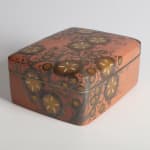Takamura Hyōkei and Jitaku
Accessory Box with Prunus Blossom Design, 1930s
Maki-e gold, silver and colored lacquer on wood
Size 5¼ x 12 x 9½ in. (13 x 30.5 x 24.5 cm)
T-4891
Further images
-
(View a larger image of thumbnail 1
)

-
(View a larger image of thumbnail 2
)

-
(View a larger image of thumbnail 3
)

-
(View a larger image of thumbnail 4
)

-
(View a larger image of thumbnail 5
)

-
(View a larger image of thumbnail 6
)

-
(View a larger image of thumbnail 7
)

-
(View a larger image of thumbnail 8
)

-
(View a larger image of thumbnail 9
)

-
(View a larger image of thumbnail 10
)

-
(View a larger image of thumbnail 11
)

-
(View a larger image of thumbnail 12
)

-
(View a larger image of thumbnail 13
)

A tebako (accessory box) of standard rounded rectangular form with slightly bowed top and sides and inrōbuta (flush-fitting) lid, the exterior covered in a pinkish lacquer likely derived from titanium...
A tebako (accessory box) of standard rounded rectangular form with slightly bowed top and sides and inrōbuta (flush-fitting) lid, the exterior covered in a pinkish lacquer likely derived from titanium (regularly used at this period) with decoration of stylized prunus blossoms and stems in gold and silver hiramaki-e and takamaki-e lacquer and other materials, the riser and interiors black lacquer sprinkled with hirame flakes of a whitish metal, the rims silver
Comes with a wood tomobako storage box inscribed outside Baika moyō tebako (Accessory box with prunus-blossom design); signed inside: Shitsugei Hyōkei saku Jitaku saku (Lacquer art by Hyōkei and Jitaku) with seals Takamura, Kei, Jitaku
Takamura Hyōkei was based in Ishikawa Prefecture during its rise to prominence as a leading center for innovative lacquer art and showed his work at national exhibitions from 1934 to 1946. His use of titanium reflects the pervasive influence of Yamazaki Kakutarō (1899–1984), an innovative artist who taught at the Tokyo School of Fine Arts.
Comes with a wood tomobako storage box inscribed outside Baika moyō tebako (Accessory box with prunus-blossom design); signed inside: Shitsugei Hyōkei saku Jitaku saku (Lacquer art by Hyōkei and Jitaku) with seals Takamura, Kei, Jitaku
Takamura Hyōkei was based in Ishikawa Prefecture during its rise to prominence as a leading center for innovative lacquer art and showed his work at national exhibitions from 1934 to 1946. His use of titanium reflects the pervasive influence of Yamazaki Kakutarō (1899–1984), an innovative artist who taught at the Tokyo School of Fine Arts.












